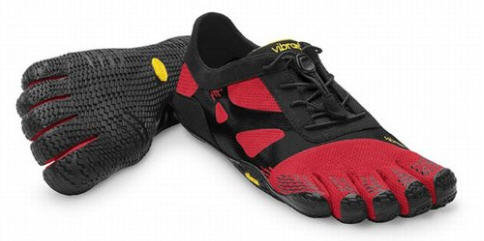
Abebe Bikile won the 1960 Olympic Marathon barefoot, and in record time.
Fast forward four years…
Abebe Bikile wins the 1964 Olympic Marathon in shoes, and in record time.
So, which one is it? I suppose the only true solution would be to ask Abebe what we need to do.
That’s what we’ll look into today. And we’re going to look at both sides of the coin – studies, statistics and what some of the professionals have to say.
For those that don’t know, Barefoot running in minimalist shoes is trending again and has been gaining popularity amongst the running crowd. As you can tell from the picture above, the idea is to run as close to barefoot (read: natural) as possible, with a little support to protect against the hard street and ground debris.
These days with social media and the rate at which information travels at lightning speed, marketers salivate at hot trends in the market… which means gathering any benefit and riding it until its death.
So, is barefoot running hype and marketing or is there some legitimate value behind it?
What’s more, is there an actual benefit for you to switch from your running shoes to this “natural” style of running?
WHY DO PEOPLE LIKE RUNNING IN MINIMALIST FOOTWEAR?
Testimonials have been growing wide in support of this style of wear. So what exactly are they saying?
- It gives them them a more natural feeling, but without the hardness and rocks that sometimes impede literal barefoot running.
- They feel lighter on their feet with a better feel for the terrain
- Mentions that a flatter shoe has cured many of their back, knee, and shin splints
- Better planting for change in direction
- Personal claims of improved performance
The benefits seem aplenty, but do wearing barefoot shoes actually account for some of these claims?
And if so, how much more benefit does it actually provide to make it worth the switch. And what does “natural feel” actually do for me?

Browsing around, there seems to be some amount of hype and perhaps some marginal benefits. But it seems like many medical professionals would urge against running barefoot altogether.
I’d have to ask
…is there even a need to switch if you aren’t having problems to begin with?
ABOUT RUNNING IN GENERAL
It has been documented that around 70% of all runners are heel strikers. Chances are, when you do your running that you’re landing on the heel of your foot.
This is a major reason why athletic shoe manufacturers spend so much money testing and marketing their specialized, branded mid and outsoles – to maximize shock absorption.
The conflicting issue is that minimalists are proponents of landing on their mid or forefoot as a means of potentially minimizing running injuries, which are in many cases claimed to be due to running style.
Of course, the popular barefoot shoe manufacturer, Vibram, has recently settled a lawsuit which claimed that the company was deceiving consumers by advertising that their shoes could reduce injuries and strengthen foot muscles without having any scientific backing to support the claim.
Part of the lawsuit settlement includes the company discontinuing those claims in their marketing campaigns.
Notes From Industry Professionals
Dan Lieberman, a Professor of Biological Sciences at Harvard University (and minimalist marathon runner), does extensive research on the biomechanics of endurance running. He often makes the correction that it’s not the shoes but the form in which you run.
Our research shows that habitually barefoot or minimally shod humans tend to walk and run differently than shod people, often in a way that leads to very low collision forces, even on very hard surfaces.
Dr. Lieberman believes it may be less injurious to run as our ancestors did – as minimalists – however, we still lack sufficient data to prove the claim.
He did, however, provide a study on the Biomechanics of Foot Strikes which show the larger impact force of a rearfoot strike versus a proper forefoot strike… though barefoot and shod runners can technically be forefoot runners.

Along the same lines, I asked the team at runbare.com if they would recommend that a runner with no existing conditions make the switch to running barefoot.
Michael Sandler, Chief Wellness Officer and Barefoot Running and Walking Coach at Run Bare, responded in kind.
…if you’re not injured now, then it’s the perfect time to work on injury prevention.
Mr. Sandler mentions that by going barefoot, you are able to strengthen your feet and move away from the “offending” footwear that we rely heavily upon for orthotic support.
He then goes on to mention the benefit of increased circulation as a barefoot runner/walker. As your feet are working harder, your body is sending more blood flow and oxygen nourishment directly to them. Read his full response here.
This could suggest that barefooting may be beneficial to inflammation injuries such as plantar fasciitis, yet there are still no direct studies to confirm the claim.
Also reaching out was Dr. Ray McClanahan, DPM, who generally echos Michael Sandler’s contribution. He also feels that, although going barefoot would definitely be beneficial to our arches, our environment is no longer compatible with going entirely shoeless.
What’s more, he notes that a tapered toebox and footwear with a toespring strangulates the flow of blood to the plantar medial heel, which he discusses in detail in this video about circulation.
It should also be noted that every minimalist suggests a gradual transition to barefoot running to prevent stress injuries.
Jenny Sanders, DPM, is a practicing Podiatrist and is a contributor to the PodiatryToday blog, where she’s openly against the practice of barefoot running.
In one post, she mentions that the majority of injury cases she sees from barefoot running are metatarsal stress fractures (ball of foot injury). Thereby implying that while some runners switch from barefoot running to eliminate the load force of heel strike, they open themselves up to metatarsal injury.
The currently available literature suggests that barefoot running produces some potentially positive changes, mostly related to alterations in running form and kinetics. That said, it also points to a potentially large group of people who — when running barefoot — have a significantly increased risk of injury, especially when initially embarking upon a barefoot running regimen. These are the people who force a forefoot landing that leads to a huge strain on the triceps surae muscles and Achilles.
But What Do The Studies Show?
Well, we’ve already briefly shared Dr. Lieberman’s study on the impact of forefoot landing versus heel strike. After that, there doesn’t seem to be the statistical backing to fully support that a move to minimalist footwear would be best.
And, although we’ve seen some benefits, as well as many advocates in support of the practice, we have to turn to actual studies to determine if one way is verifiably better than the other.
1. Study on Running Economy
In a recent study performed to measure the difference in running economy through Vo2 (oxygen consumption) and %CHO (carbohydrate contribution to total energy expenditure) between 19 habitual forefoot and 18 habitual rearfoot strikers, it was determined that forefoot strikers were not more economical than their counterparts.
Allison Gruber, Postdoctoral Fellow at UMASS, found that rearfoot running appeared to have burned fewer carbohydrates than forefoot running, which would be of particular importance to distance runners who need to conserve carbohydrates.
Because depleting carbohydrates results in ‘hitting the wall,’ or abruptly sagging with fatigue, these results tell us that people will hit the wall faster if they are running with a forefoot pattern versus a rear-foot pattern.
Peter Larson of Runblogger provides a thorough analysis of the data, interpreting some of the individual data points.
He further goes on to assume that, as a veteran runner, most people go on to make the switch to barefoot not as a means to race faster, rather because they enjoy it and/or that running shoes no longer work for them.
2. Study On Barefoot Running To Reduce Injury
Another study performed to determine the effects of barefoot and barefoot inspired footwear on knee and ankle loading during running provided sufficient support to conclude that it may serve to reduce knee injuries in runners, but at the expense of additional load to the Achilles tendon in comparison to conventional footwear. Which coincides with Dr. Jenny Sanders’ findings.
CONCLUSION
What then can we take from this mash-up of studies and expert opinions? The same thing that we learned from Abebe Bikile. Not much. Like marketers that use hype and hope to sell products (cough, cough, Vibram), there seems to be a lot of promotion based on insufficient data either way.
It seems to me, however, that you should stick with what your Podiatrist advises much the same way that you look to a Primary Care Physician for medical advice. They no doubt have a large flow of people through their practice and will know what works based on their own patient data sets. And many professionals will suggest to simply do what works for you. If you feel like running barefoot, take it slow.
I see no reason to change a good thing if you aren’t faced with chronic injury, but if you choose to look into barefoot running, perhaps you need to follow the advice of those that practice what they preach, like Sandler and McClanahan – who both run as well as study deeper into the biomechanics of running barefoot.
Like and Share on the left if you found this useful.
